Boards & Governance
Board Monitor India 2024: Six ways boards are reshaping their processes to thrive now
Our analysis of the newest class of directors added to NSE 500 boards, and historical trends in the backgrounds of people being added to those boards, is available here.
More satisfaction with where the board spends time includes more time spent on CEO succession planning
CEO succession planning falls near the bottom of the list of areas where directors around the world say they’ve spent more time post-Covid, 11th out of 13 options. However, 40% of directors who say their time is spent in the right places say they’ve increased time spent there, compared with only 28% of those who aren’t satisfied. This suggests that at least some directors are concerned that succession planning is not receiving the attention it deserves—a reasonable concern given the findings of other recent research we’ve conducted showing that 57% of CEOs and directors had little or no confidence that their company’s CEO succession planning was positioning the organization well for the future.
More operational involvement in privately owned companies
Globally, 77% of private company respondents—those at family-owned companies, private equity or venture capital–backed companies—report more operational involvement by the board, compared with only 70% of public company directors.
Thirty percent of private company respondents report operational involvement happens frequently.
Private company respondents also say board members get involved for different reasons:
- 39% say it’s because the board has specialized knowledge the executive team does not have, compared with 33% of respondents at public companies
- 16% do so because the CEO does not have the bandwidth to handle increased responsibilities and needs help from the board, compared with 12% of respondents at public companies
There is, of course, less regulatory burden on privately owned companies and greater expectation of board member involvement overall as board members are, on the whole, direct owners.
For many years, Heidrick & Struggles has been tracking the trends that have shaped the global governance arena including important long-term changes in board independence, diversity, financial oversight, risk management, and in the shareholder base the directors serve.
More recently, we have been helping our clients understand the expanding environment in which they are operating. How is the role of business in society changing? What are the implications for directors? What does the future hold?
Clarity has been hard to find as directors struggle to draw reasonable boundaries and consider their responsibilities in the midst of a rolling global pandemic, geopolitical uncertainty and conflict, emerging technologies, cybersecurity concerns, and a long list of social and environmental concerns. Ongoing regulatory changes across markets have also contributed to changing norms; to keep pace with the evolving environment, the Securities and Exchange Board of India (SEBI) regularly keeps amending the Listing Obligations and Disclosure Requirements (LODR) Regulations to “enhance corporate governance, streamline compliance, and improve shareholder engagement for listed entities.”1
In India, the stakes are heightened further by robust economic growth. India is well on its way to becoming the world’s fourth largest economy, and by 2030 it’s projected to be the third largest, behind the United States and China.2 This growth will attract long-term commitments from global investors, along with new expectations for board performance.
“Corporate governance in India has never been so varied or exciting. The intensity varies between companies and boards, but is driven by turnover of independent directors, global uncertainties—which seem to be peaking—energy transition, sustainability, and the impact of, and investing in, appropriate technology. Add to this the constant churn in regulatory and accounting requirements. If we were to accept the premise that the most important decisions for society are made within boards, clearly this is the best of times for boards.”
OP Bhatt, independent director and former Executive Chairman, State Bank of India
Despite differences from one market to another and one company to another, most accept that the role of the board is expanding. More is at stake. More is uncertain. And more is expected now of directors.
"Today’s boards are confronted with growing complexities driven by technology such as AI, stronger governance and an evolving marketplace. Working towards aligning with long-term growth and shareholder value creation, it is essential to assemble a strong and diverse board of directors - ones who are engaged and prepared to guide the business in tackling future challenges. This process focuses on bringing together a robust mix of expertise, but also board members who possess strategic foresight and a deep understanding of how the industry is evolving. A well-balanced board needs to be agile, adapt quickly to changes, align and be supportive of one another, while balancing immediate needs with a clear vision for future opportunities. As demands grow more complex, boards must guide and prepare their organizations to be succession-ready, positioning the business for future success in an ever-changing landscape."
Puneet Pratap Singh, partner in charge, India, Heidrick & Struggles
With all this in mind, both the regulator and boards will need to ensure that companies follow robust corporate governance norms to provide the competitive advantage, transparency, and trust for investors and stakeholders that will underpin even faster economic growth in the coming years.
While this expanding role creates added pressures, it is also creating opportunity. New approaches are emerging for boards and individual directors who see promise in this shifting landscape. In what follows, we draw on the results of two recent surveys of CEOs and directors around the world, and our experience, to describe how directors and CEOs are answering six questions that are reshaping the boardroom.
Six questions reshaping the boardroom
- Who is influencing the board agenda today—and are board members happy with that?
- Where does the board spend its time—and are those the right places?
- How are boards addressing the widening risk environment?
- Are boards more operationally involved?
- How should boards engage with the workforce?
- How are boards thinking about diversity today?
Who is influencing the board agenda—and are board members happy with that?
The concept of stakeholder capitalism has been around for more than 70 years, going back to at least as early as the 1950s, when W. Edwards Deming wrote that “the aim proposed here for any organization is for everybody to gain—stockholders, employees, suppliers, customers, community, the environment—over the long term.” The concept has been at the center of constructive debate since.
To better understand the relative influence of stakeholders today, we asked directors and managing directors to stipulate which stakeholders have accelerated their influence most in the post-Covid environment. Globally, they report that the managing director (CEO) and leadership team, the broader workforce, regulators, and consumers and customers have increased their influence more than others. Respondents in India had the same list, but with regulators first. Respondents in India also reported increased influence from every group we asked about more often than leaders in other regions.
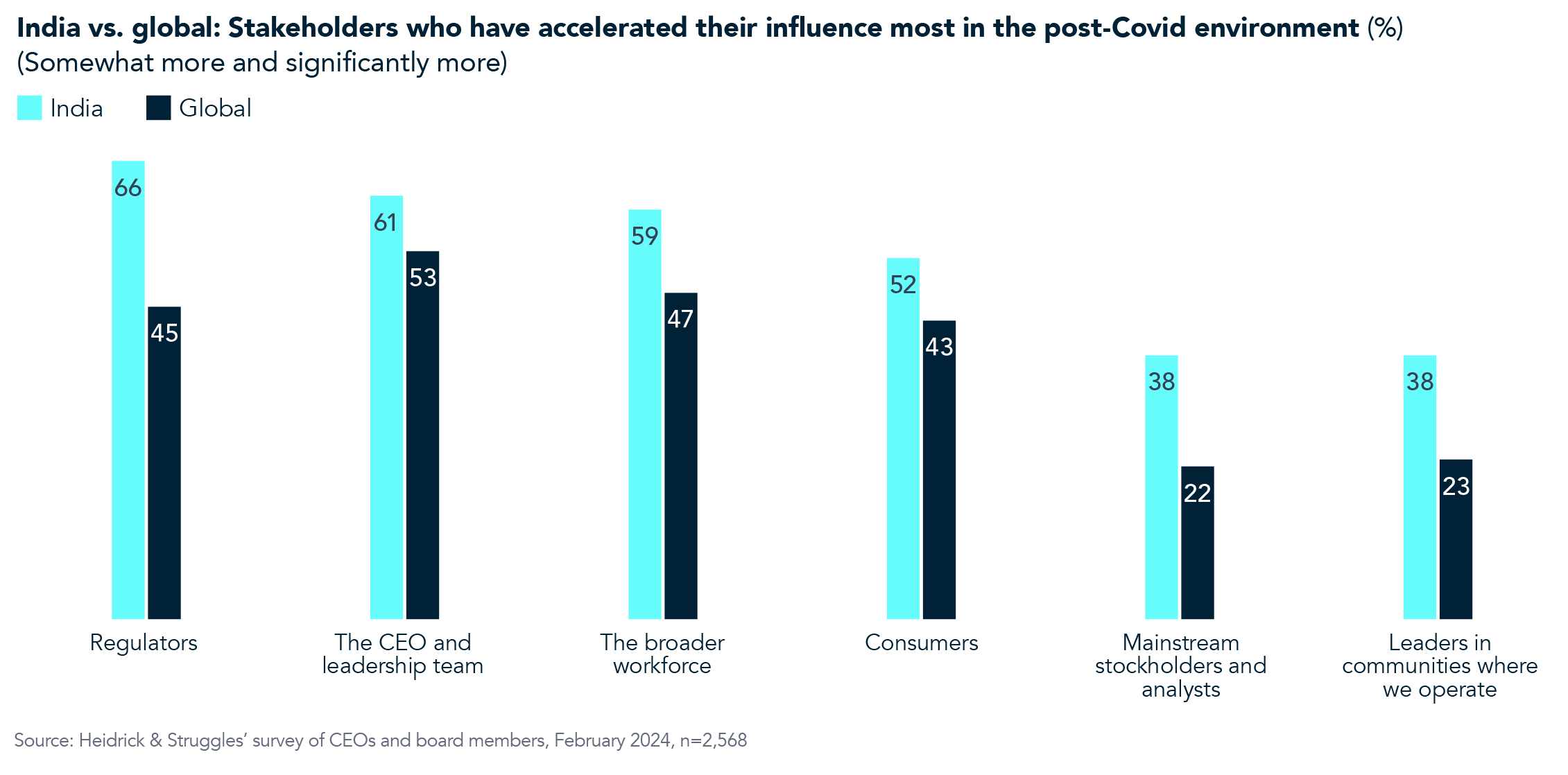
The regulator SEBI imposed a ten-year limit on NEDs in 2014.3 This led to what has been called “the Great Board refresh,” in which companies sought to onboard large numbers of new directors during 2024 and now 2025.4
“Increasingly, whatever we do, or need to get done, is done less and less by individuals and more and more by institutions such as corporates, trusts, societies, other bodies. All major decisions, for institutions from the UN to national governments, from businesses to philanthropic foundations to building societies, are being increasingly taken in such structures. Because of diffused [shareholders], these institutions require a two-tier stewardship structure. One for day-to-day, hands-on activities, and one with members with diverse experience, some detachment, and influence to ensure the ship sails true. In today’s world, beset with issues like climate change, AI, or global discontent, all these factors influence or have impact on most decision making at the board level. Hence, possibly the most significant and interesting times for the board.”
OP Bhatt, independent director and former Executive Chairman, State Bank of India
Satisfaction with level of influence
We also asked respondents how satisfied they are with the current influence of stakeholders, generally and on a relative basis. A majority of respondents globally report a high level of satisfaction (76%). In India, 79% are satisfied.
- Globally, leaders who report less satisfaction with the stakeholder mix more often also say that regulators, activist shareholders, and social activists have more influence than before Covid on the board agenda. They also more often report increased time spent on financial performance and stakeholder concerns.
- Those reporting the highest levels of satisfaction with the current stakeholder mix globally also report spending increased time understanding emerging technologies, AI, and cyberrisk. They also most often report that the leadership team has more influence post-Covid.
The forces that influence board governance are hard to predict. The importance of attracting and retaining worker and customers has never been higher—and is likely to continue. For all that has been written about the rise of shareholder access and scrutiny, it is only starting to take hold in the boardroom, relative to other stakeholders.
“Boards in India are driven by the compliance calls of the regulators, which is largely a good thing. Financials and audit detailing are subject to scrutiny and detailed discussions, thereby genuinely minimizing financial risks or pitfalls for shareholders.”
Sangeeta Singh, independent director
Where does the board spend its time—and are those the right places?
“Boards in India, and indeed the world over, have an ever-increasing set of responsibilities from a governance standpoint. In order to provide adequate and effective stewardship and oversight to the organization, boards are now required to become knowledgeably aware of a vastly enhanced range of issues and their implications on the business. This is particularly challenging as at the same time the business environment has become increasingly volatile and complex. Boards therefore need to continuously reimagine their role to be at the cutting edge of the thinking on corporate governance.”
Madhavan S, independent director and former senior partner, PWC
As new influences come to the fore, more and more companies are learning to thrive in this environment, adjusting to consider and address an expanding number of issues. Boards are also shifting how they spend their time. We asked directors and managing directors both how they split their time in meetings and which topics receive more of their attention in a post-Covid environment.
Allocation of meeting time
There is broad agreement globally, among both managing directors and directors, that the board meeting agenda remains primarily focused on “traditional board oversight responsibilities” (financial performance and risk, stockholder concerns, and strategy reviews, for example) and “traditional board leadership responsibilities” (managing director succession planning and leadership performance and compensation, for example). Together, these categories take up nearly 60% of boards’ time. External global risks, the opportunities and risks associated with technology (AI and cyber) and other stakeholder issues capture about 10% each in the balance of the meeting schedule. Crisis management and other topics round out the balance.
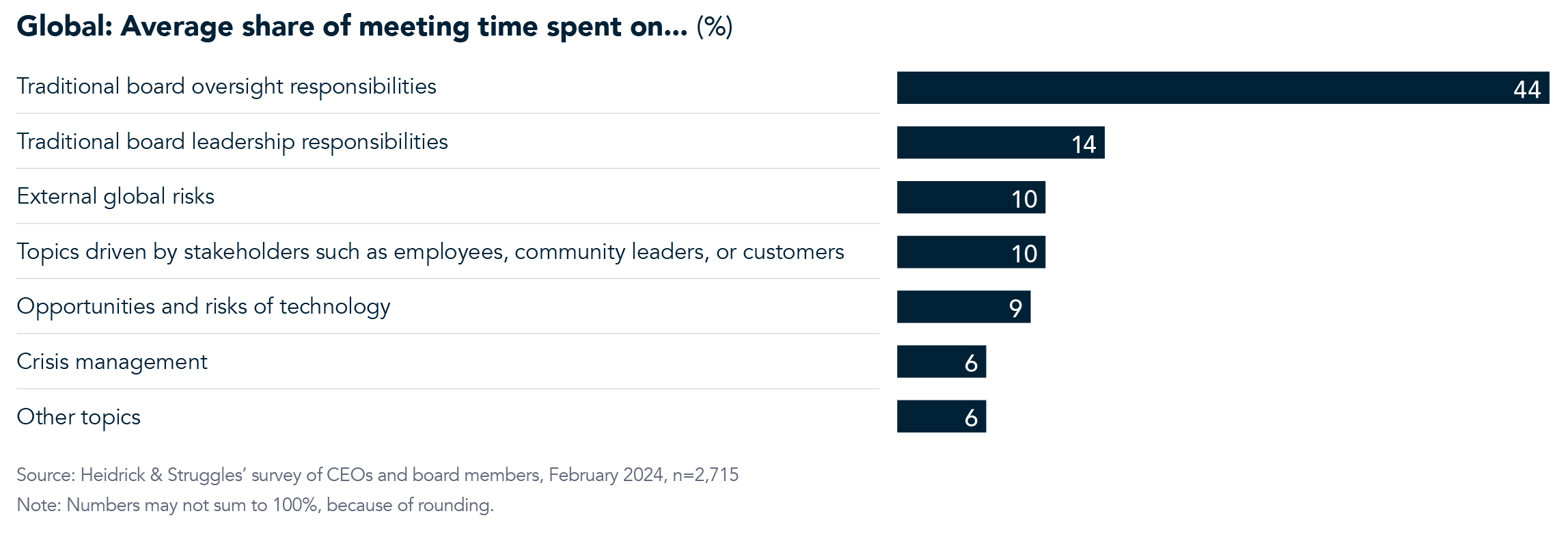
“New age boards are transitioning from compliance-driven oversight to a forward-thinking and strategic partnership. Boards need to focus on effective governance, prioritizing risk management, ESG and sustainability, and digital transformation. They also need to help create a resilient culture by ensuring that the people agenda is effectively dealt with. Shareholders today are viewing corporate boards playing a more crucial role than ever before.”
Richard Rekhy, Vice Chair, Grant Thornton Bharat and former CEO, KPMG India
Most pressing topics now vs. pre-Covid
Globally, more respondents report spending more time on emerging technologies/AI and cybersecurity compared to pre-Covid than any other category. Leaders in India report spending more time almost everywhere.
“Diverse stakeholder influence and a complex environment with new technologies, cybersecurity issues, and societal expectations are rapidly evolving the governance landscape. Boards are broadening their traditional oversight and dedicating more time to understanding operational challenges and managing risks.”
Ravi Kirpalani, independent director; Chairman, Foseco India Ltd.
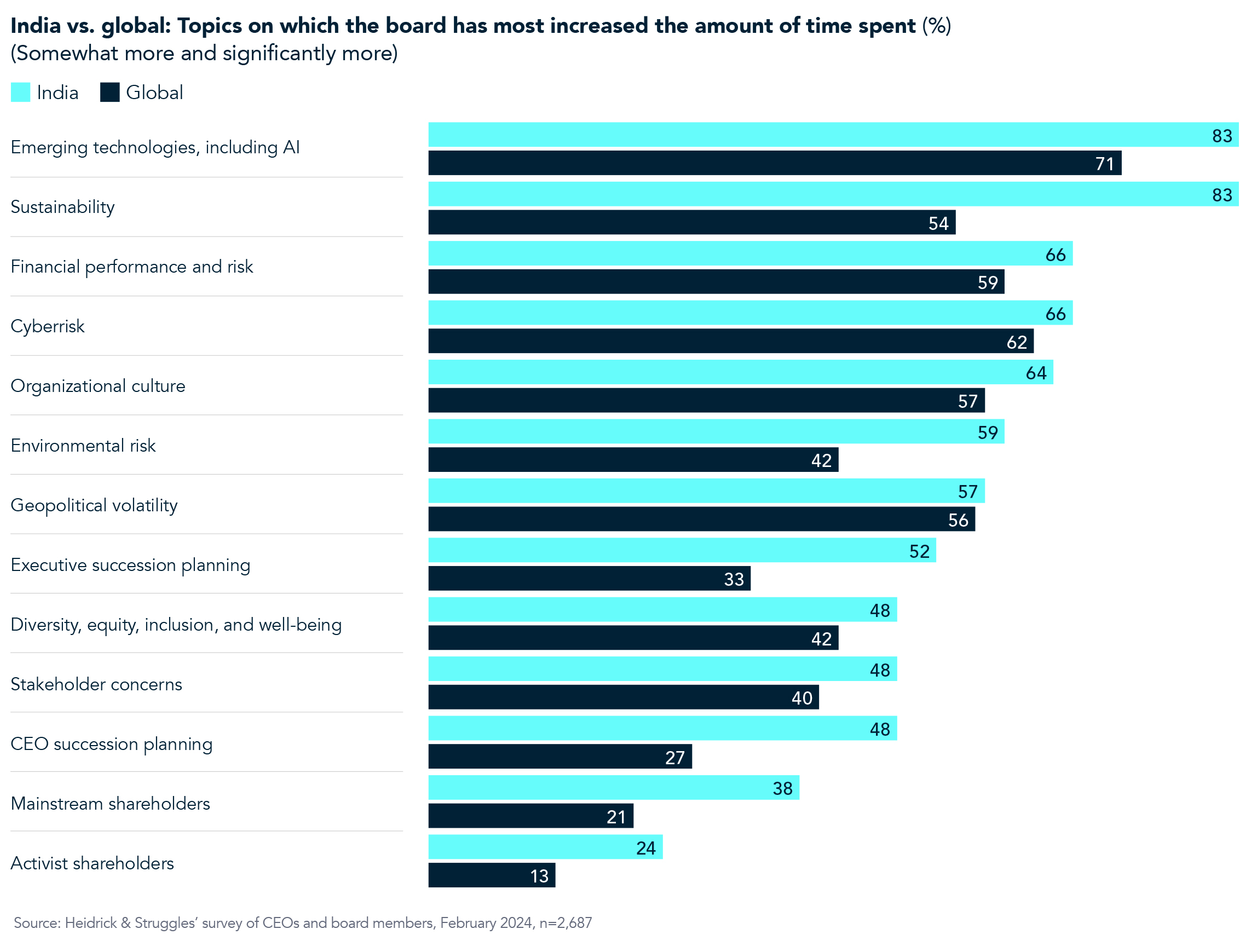
Globally, respondents at larger companies, those with more than $1 billion USD in annual revenue, report spending more time in every area, except financial performance and risk, while their counterparts at smaller companies are more often spending more time specifically in that area. Respondents at public companies are also more often saying they are leaning into emerging issues compared with their private company counterparts.
The board landscape has always been in flux, and directors have always adjusted. In the same way that the push for independence, board diversity, and stronger financial oversight substantially reshaped today’s boardroom, directors are again testing traditional boundaries as they consider addressing demands from an expanding and more influential set of stakeholders, and on a growing list of issues considered “external” and less relevant in the past. We now turn to the ways in which the most effective boards are responding.
How are boards addressing the widening risk environment?
“As Indian corporations mature and compete at a global level, there are a couple areas that need more involvement, time, and inputs from external experts. First, reputation risks. This goes beyond just share prices or rating agency comments. It is important for companies to be concerned about how they are viewed in terms of equitable pay, gender sensitivity, a culture of recruitment inclusivity (such as hiring from Tier 3 towns or institutes), meritocracy, and a commitment to employee well-being. Second, innovation risk. Are our companies truly striving for innovation? How are we giving innovation the focus, culture, and resources it requires?”
Sangeeta Singh, independent director
Most directors accept that the complexity, intensity, and accelerating rate of change in the boardroom requires a new approach to governance. Ironically, perhaps, in an environment where there is a call for leaders to have more expertise on every topic, what really helps them succeed are wisdom, business judgment, and learning. These capabilities have never been more important. Governing in this environment requires new and practical approaches to ensuring expertise and managing risk.
To better understand how boards are adjusting to this new reality, we asked what steps they have taken since Covid began to better manage uncertainty and risk. Respondents remain anchored primarily in risk management practices that are “internal” in nature; that is, derived from interactions among the board itself and between the board and management. However, we also see a growing willingness to draw in the contributions of “external” experts.
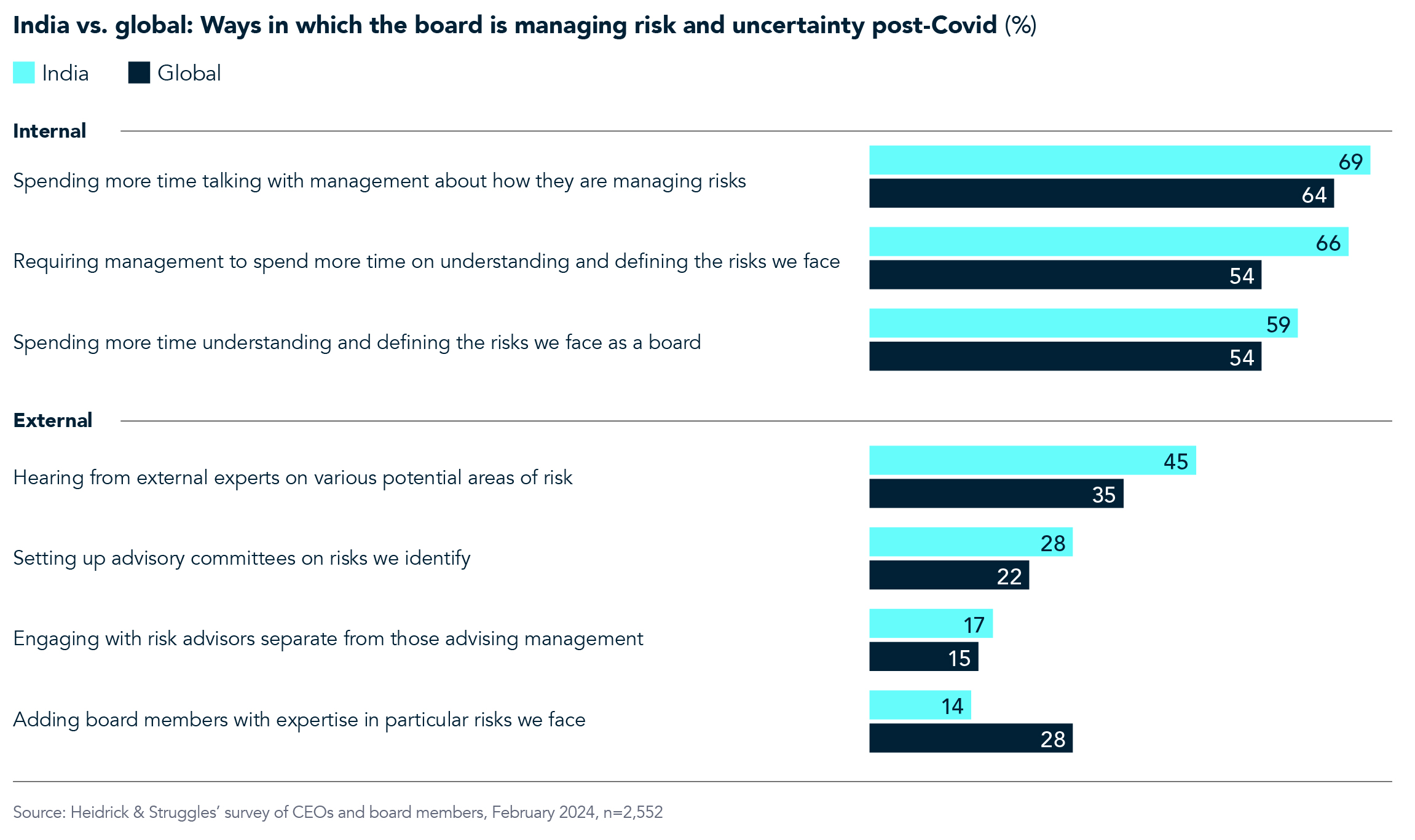
In India, both SEBI and the Ministry of Corporate Affairs have been steadily pushing for enhanced governance and risk management among boards of both listed and unlisted companies. One category that has been coming under scrutiny is start-ups, where we have seen a few incidents of governance challenges leading to significant capital erosion, which have further led to change of auditors and resignation of NEDs. In another significant development, SEBI has circulated a consultation paper to seek views on expanding the requirement to have a risk management committee from the top 1,000 listed companies to the top 2,000.
At the global level, there are some notable outliers on steps boards have taken.
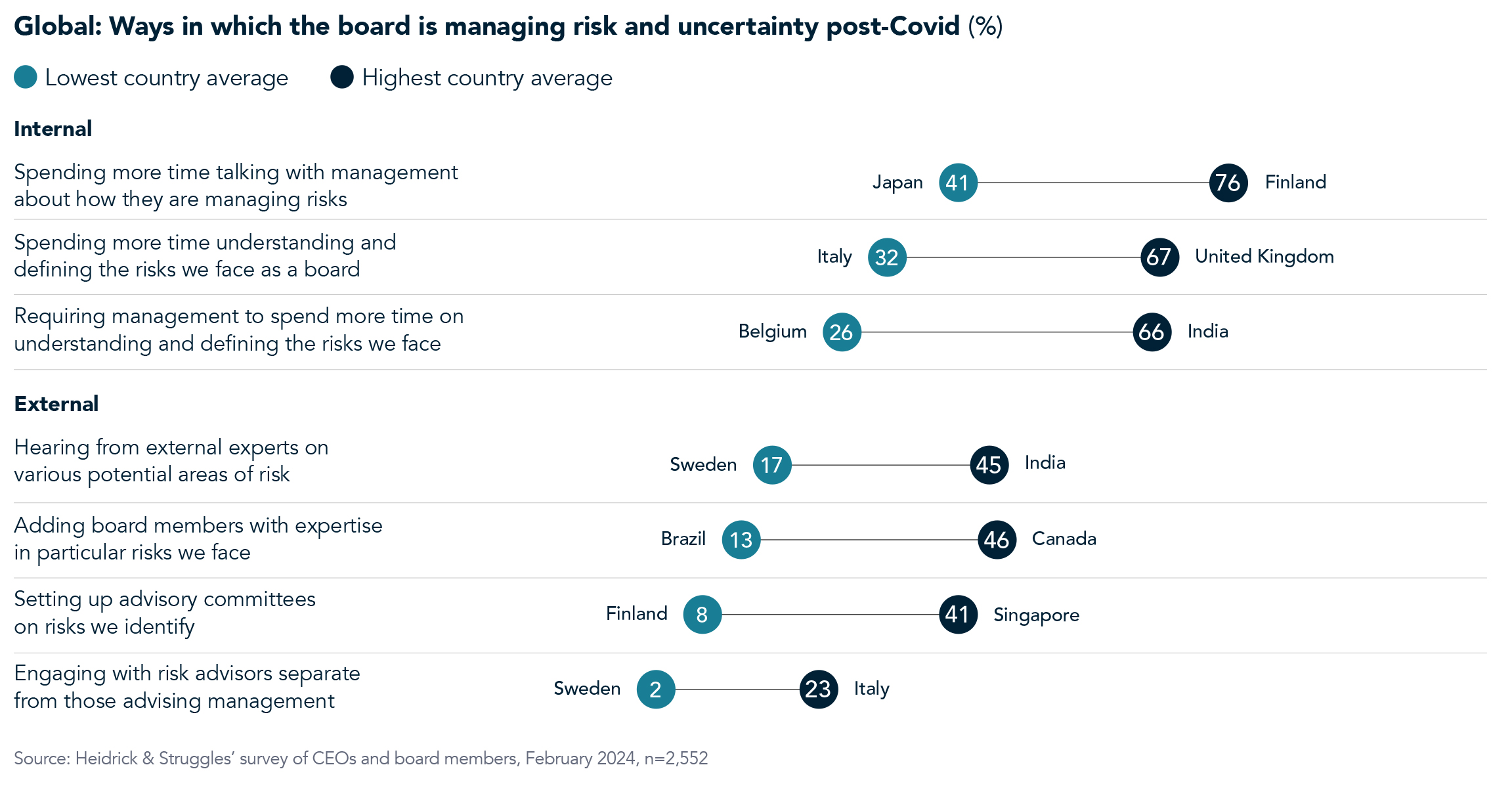
Perspectives across sectors and company types
- Globally, respondents at financial services companies, more than those at companies in any other sector, have most often taken active “external” steps to address risk and uncertainty: 41% have added board members (versus 28% overall); 44% use outside experts (versus 35% overall); and 24% use advisory boards (versus 22% overall).
- Consumer company respondents say they have least often added external risk management resources: 23% have added board members (versus 28% overall); 31% use outside experts (versus 35% overall); and 21% use advisory boards (versus 22% overall).
- Public and private companies alike have accelerated their risk management efforts, but public companies have accelerated more aggressively than private companies in every tactic we asked about.
- Respondents at larger companies more often than those at smaller companies report they are adding outside board members or hiring external experts.
Post-Covid, the risk landscape has widened for businesses. While companies remain anchored in financial and operational risk management practices, the spectrum is growing and now includes significant emerging cyber, AI, and geopolitical risks on top of growing environmental and social concerns and regulations. Increased investment, both internally and externally, is paying off for companies that invest in novel approaches to expanding capacity and expertise.
Are boards more operationally involved?
“Boards need to spend more time with their leadership team and encourage them to reimagine their business (in a three- to five-year time frame) in order to remain relevant and resonant with their customers. In the VUCA world, with all its geopolitical risks, one of the things that often gets missed is the way consumers and customer needs are changing—how their behaviors are changing and what this means for business. Even in the case of B2B businesses, the democratization of access may reshape requirements. Other things that get missed are the accelerated pace of technological change and changing business models—for example, the rise of GCCs, role of emerging markets as talent hubs, effect of restrictive trade initiatives cross border, and so on. Boards must consider how all of this comes together to impact the business both today and tomorrow.”
Sangeeta Talwar, independent director and ICF Certified Leadership Coach
Few dispute that more is at stake and more is expected of directors now.5 As the role of business in society expands, directors have been grappling with the boundaries of their respective roles. This has accelerated since Covid and is testing the sacrosanct “nose in, fingers out” standard that marks an important boundary between the board and management in ways we have not seen until recently.
To better understand this complicated issue, we asked directors and CEOs the following question: “There is an impression that many board members are more operationally involved than ever before, some crossing the traditional line between oversight and management. Have you seen this on your board?”
Globally, a majority of respondents report that board members are more operationally involved: 25% say it happens frequently; 45% occasionally; and 4% that it has happened once. Only a quarter report that they have not crossed that line. Notably, CEOs more often than directors report operational involvement from the board.

Leaders in India more often say they are frequently involved than their global peers, putting India near the top among countries in our survey.
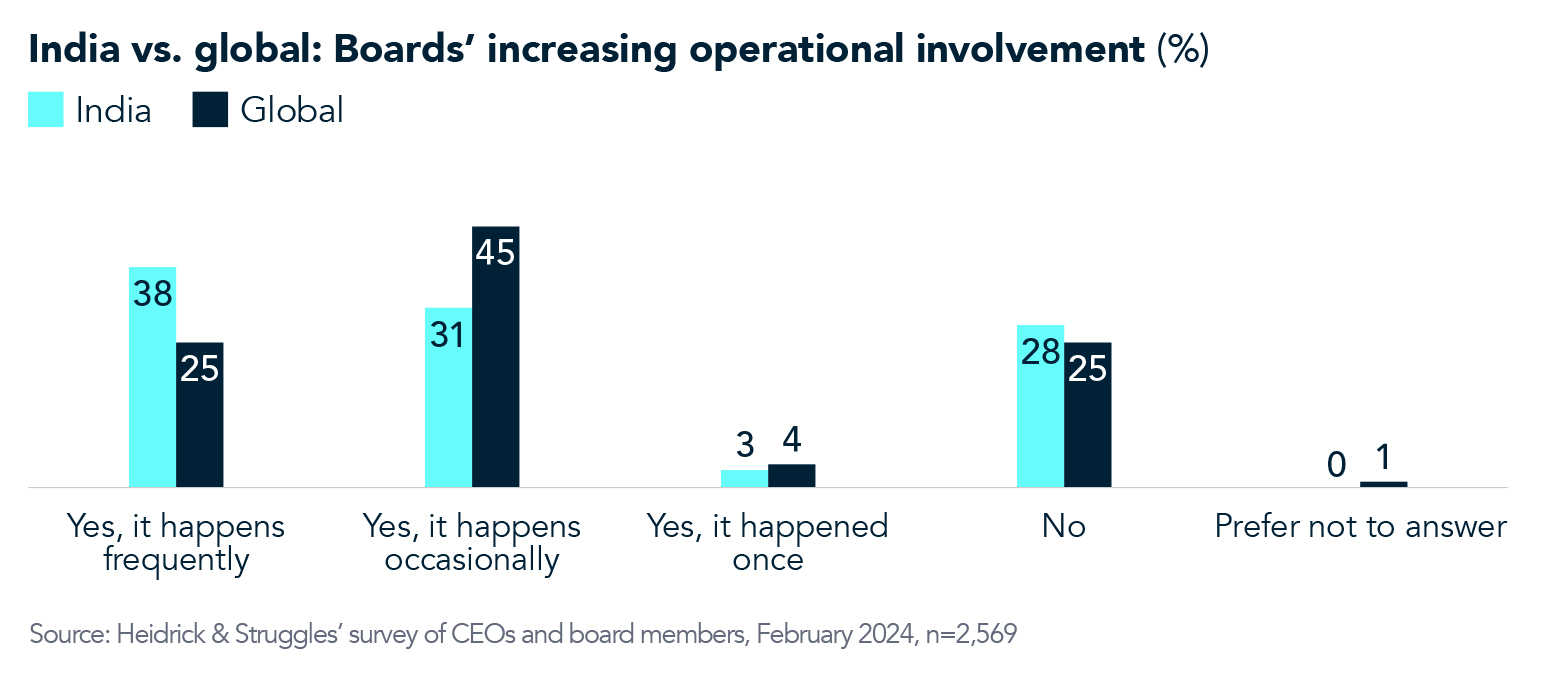
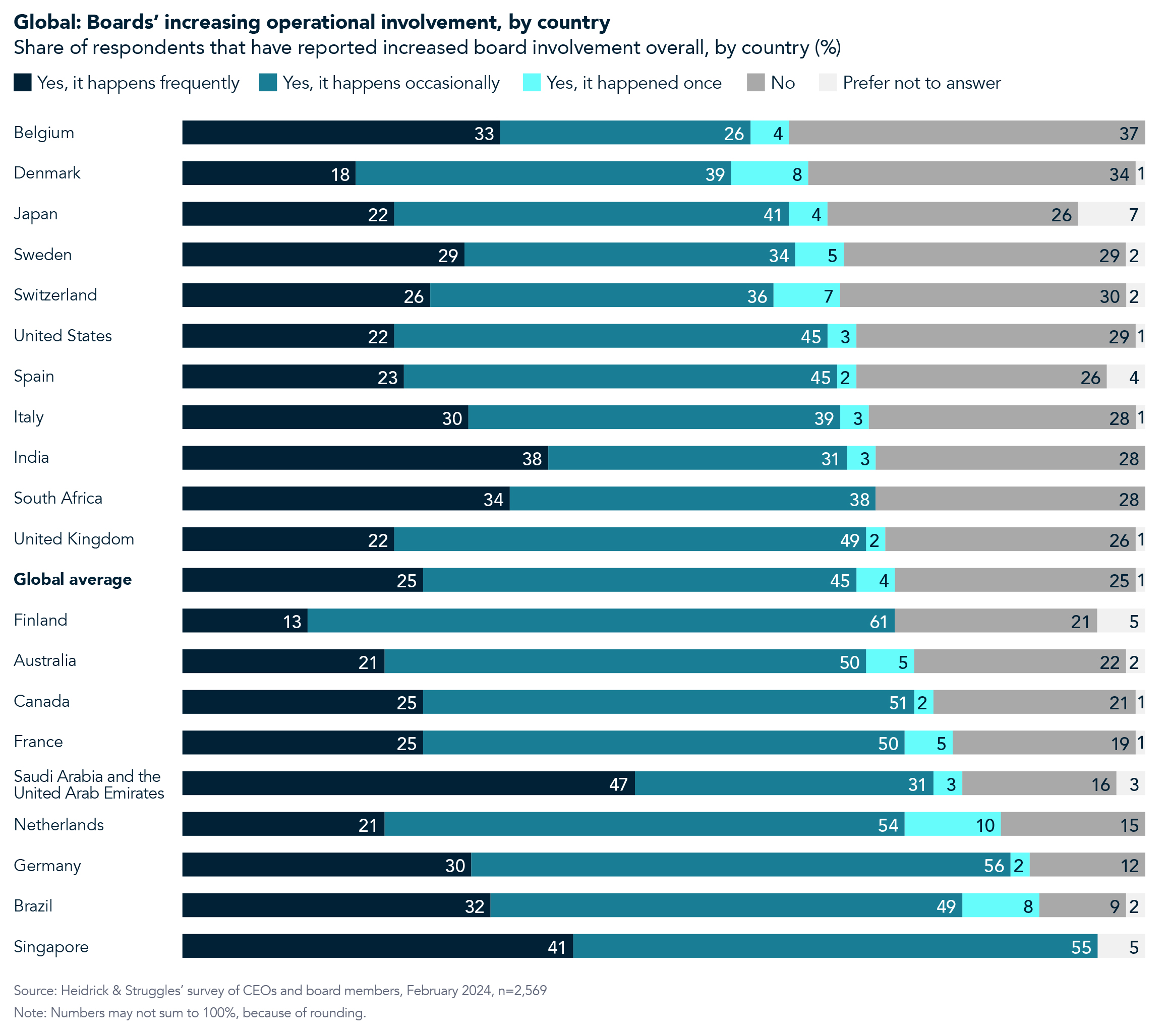
“Indian companies are growing in size, scale, and complexity, and steadily expanding their global footprint. Corporate governance in India continues to evolve, with a heightened focus on the role of independent directors. It is clearly understood that transparency, accountability, and improved oversight cannot be mandated solely through regulations; they need to be ingrained in a company’s ethos. And that mantle is carried by the independent directors, to strike a balance between governance oversight and constructive support to the management. We see independent directors exercising increasingly greater influence to curb conflicts of interest, and in ensuring that their boards are truly impartial and capable of holding management accountable.”
Suresh Raina, partner, CEO & Board of Directors and Industrial practices; Heidrick & Struggles
What reasons do leaders whose boards have gotten more operationally involved cite?
- CEOs most often say it’s because board members want to learn more about operations than regular reporting allows.
- Directors most often say it’s because they have specialized knowledge the executive team doesn’t.
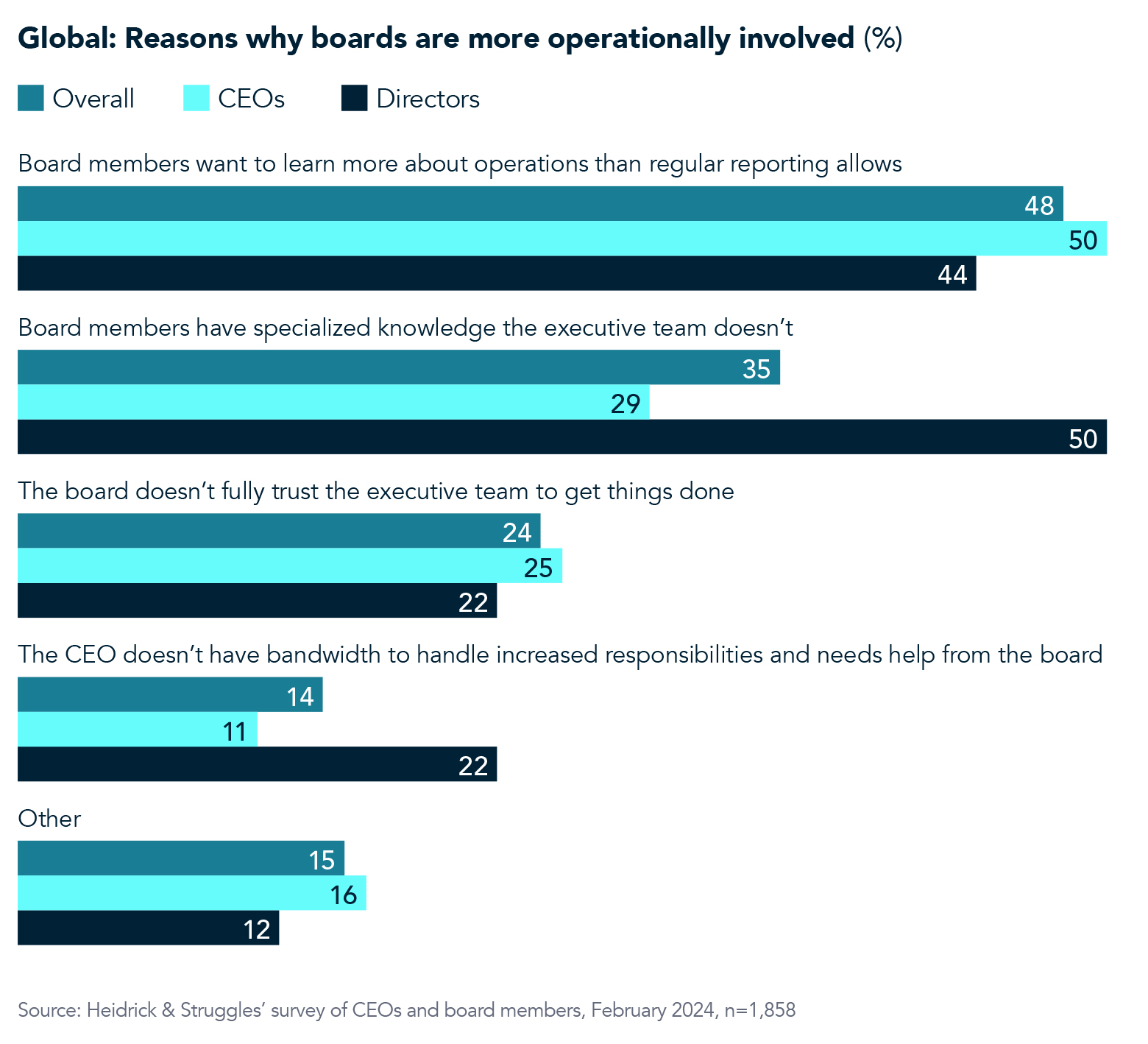
In India, respondents by far most often cite a desire for operational knowledge.
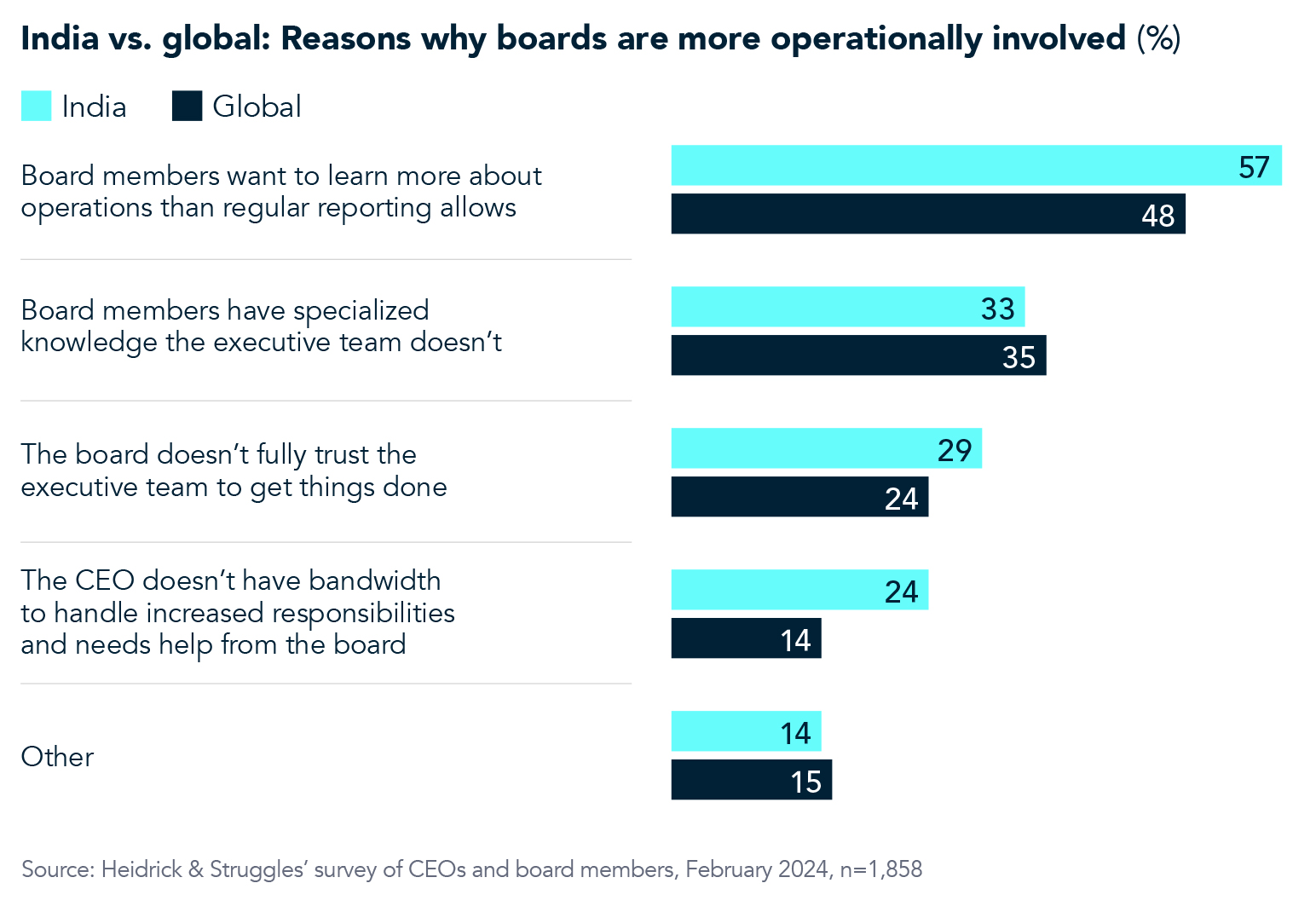
How are boards engaging with the workforce?
Workers are increasingly influencing the board agenda globally. A number of trends are driving this, including demographic changes, income inequality concerns, talent shortages, inflation, the resurgence of labor unions, and the proliferation of social media organizing platforms. To better understand the impact of this on how the board does its work, we asked respondents how they think they should engage with employees other than the most senior executives. A significant majority (86%) believe directors should engage with employees deeper in the company; only 13% believe they should not (the rest said they didn’t know). The figures are similar for India.
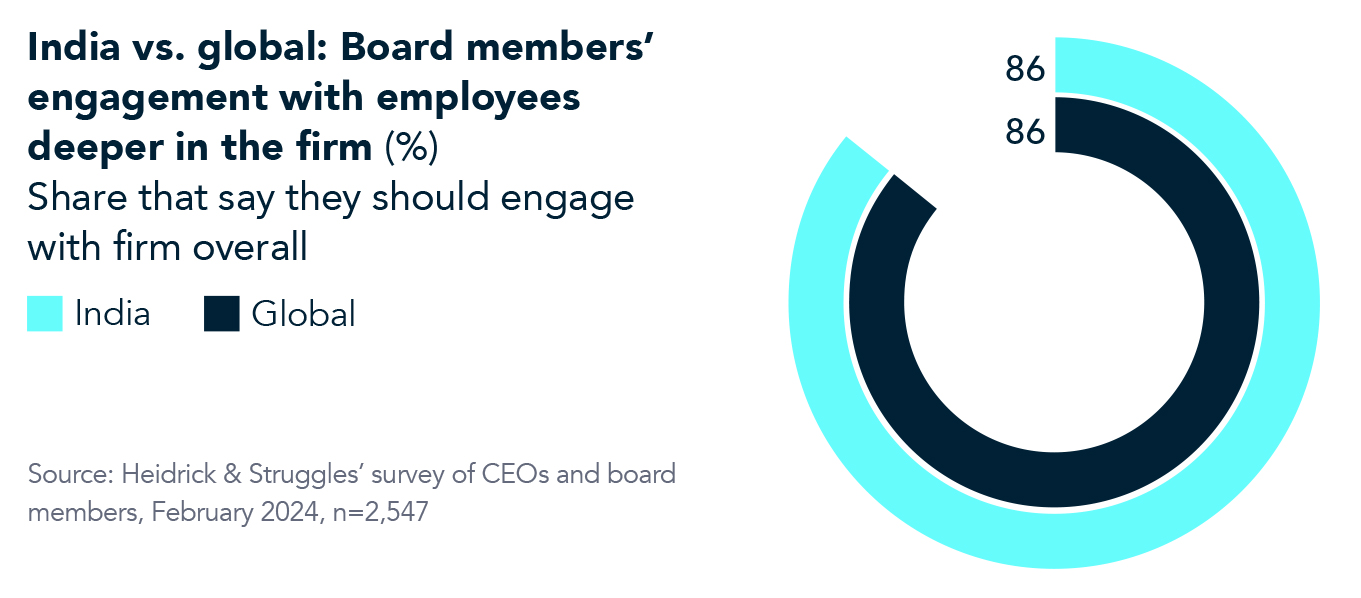
On a global basis, respondents most often preferred to engage with the workforce through the use of surveys, town halls, and direct engagement with small groups of employees without management present. Leaders in India are particularly focused on third-party surveys, followed by small-group meetings.
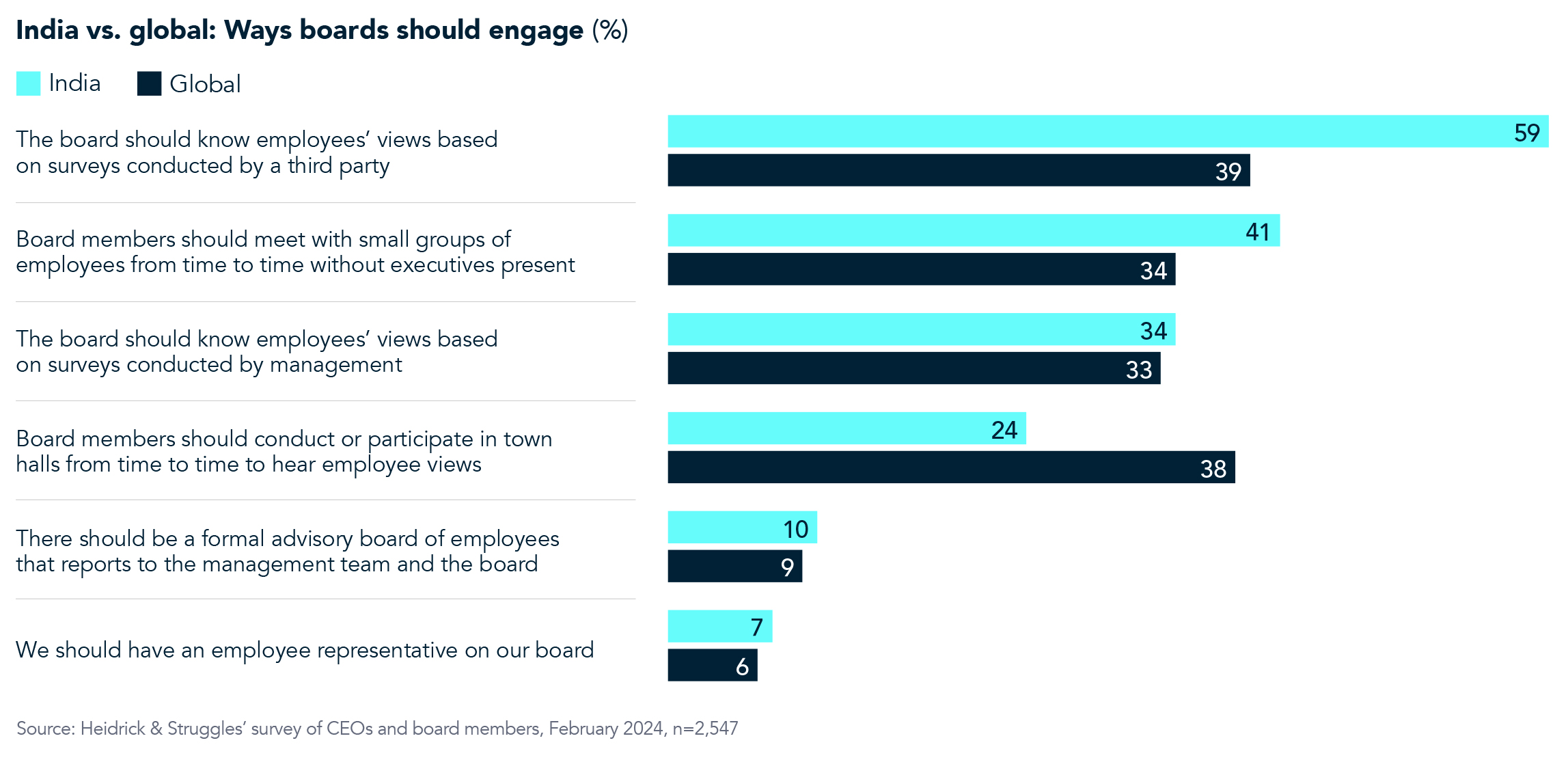
Perspectives across sectors and company types
- Respondents at larger companies more often favor engagement with small groups of employees without management present than those at smaller companies (42% and 32%, respectively).
- Respondents in the financial services sector most often favor engagement with employees without management present; 44% compared with a high of 35% in other sectors.
Given the growing influence the workforce has on business globally, it is not surprising that directors are engaging more and exploring novel approaches to understanding the needs of this increasingly important stakeholder. While reticent to allow formal engagement approaches, most directors—with the support of many but not all CEOs—are interested in more direct interaction.
How are boards thinking about diversity today?
The business world, for all its faults, has proven its ability to respect our differences, using them as a source of valuable debate, and to work above and around our divisions to solve complex problems, drive innovation, and create value. This is perhaps why business has a trust edge over the government and the media. For most of us, this edge is hard to put into words, but you know it when you feel it—that lift inside when you realize your colleagues, customers, and employees don’t necessarily live, vote, or pray like you and you couldn’t care less. This is when business is at its best. Governing and leading across abiding cultural divisions may be the most important thing business has to offer society.
Diversity among the newest directors
For the first time, we have analyzed data on the backgrounds of directors added to NSE 500 boards in 2023. Three notable data points are below. There was a very small share of directors from other countries being named to these boards, but a much greater focus on directors with experience in different industries.
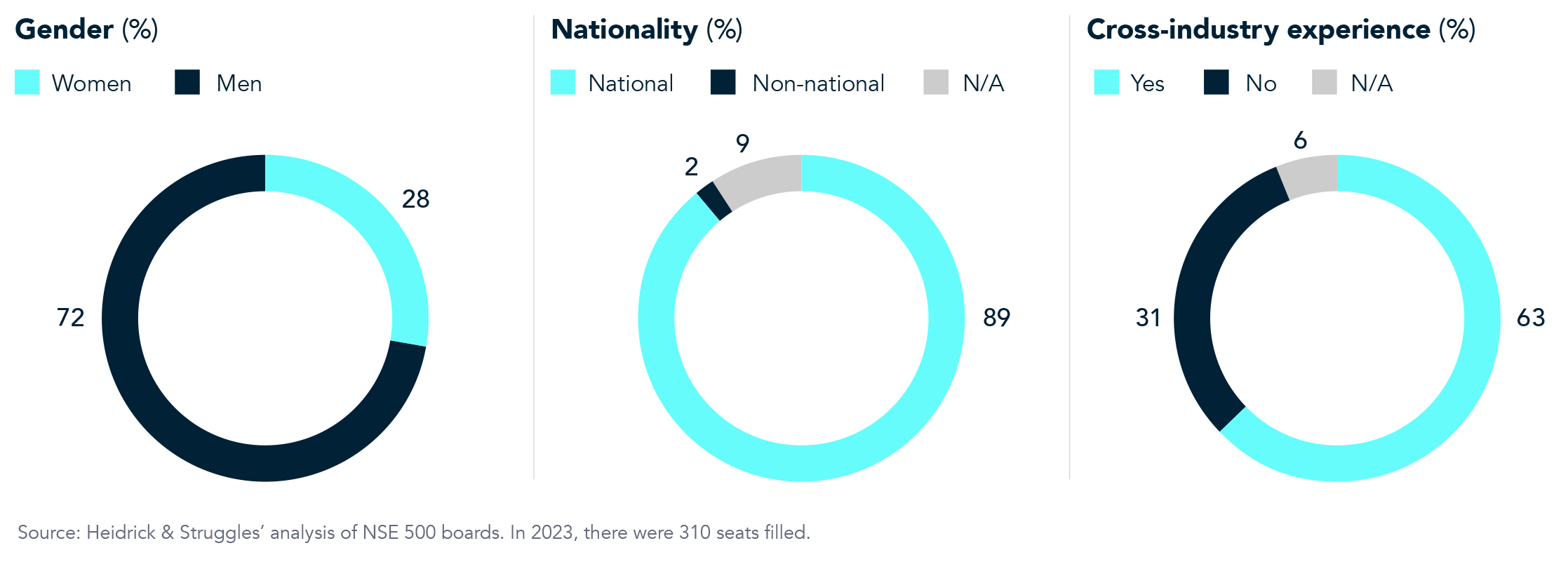
Recommendations
Change is a constant, and this has been particularly pointed for directors in recent years as society looks to business for more than it ever has. But the fog is clearing for boards that are learning to adapt. Many are finding that societal impact and shareholder value can go hand in hand, and, if managed well, the director role can be less overwhelming and more rewarding.
“In today’s volatile environment, marked by rapid technological changes, challenges, and crises, boards must be reflective, and leverage their collective wisdom to stay ahead. They need to prioritize and prepare their companies to excel in building an architecture of intangibles, such as culture, distributed leadership, human capital, innovation, branding, and reputation, to drive tangible business outcomes on a sustainable basis. This will foster resilience, ensuring competitiveness and growth. Smart board leadership—rooted in a transformational mindset, calculated risk-taking, and a focus on robust human processes—will be the cornerstone of sustained success.”
Anil Khandelwal, corporate governance advisor and former Chairman and Managing Director, Bank of Baroda
Following are a set of recommendations to consider, reflecting adjustments effective boards are making.
- Increase stakeholder engagement
- Cultivate a learning culture on the board
- Expand sources of expertise
- Increase investment in succession planning
- Diversity across boundaries
- Board effectiveness
Several good boards are increasing engagement with stakeholders of many kinds. Most directors are increasing their commitment to ensure the voice of non-management employees are heard in the boardroom. Boards are engaging with CXOs and the top talent in the organization in a structured format.
Directors are accustomed to being hired for their expertise—for being experts. This won’t change, but the scope of expertise required is expanding beyond the capacity of a traditional board. In this environment, “learning to learn” and business judgment have never been more important. Effective chairs set the tone for learning.
Still, a growing number of boards are also using mechanisms such as advisory committees and external advisors, and in some cases inducting directors with global experience and expertise to surround the board with the range of rapidly changing skills needed to create capacity and govern in this expanding environment.
“A well-rounded board with varied domain expertise is critical. The chairman must clearly set the annual board agenda, while committee chairs outline themes for the year based on current challenges and opportunities. These inputs should be consolidated into a strategic document capturing annual and short-term priorities.”
Rakesh Makhija, Independent director; Chairman, Castrol India Ltd.
In this widening risk environment, and with rising investor pressure on directors, effective boards are adopting an ongoing approach to succession planning—for both the CEO and board itself. While reactive recruitment projects continue, many progressive boards are increasingly adopting this best practice. Still, our research shows concern among many directors that succession is being pushed down the priority stack and not actively addressed.
The new face of diversity includes and goes well beyond traditional definitions and boundaries. The implications for business are far reaching. Whether it be due to regulatory push or boards’ own desires to introduce diversity in the boardroom, boards must make certain that director candidates bring experience, wisdom, and empathy, along with diversity of gender, nationality, and background, and proven reputation of working across societal and inter-company boundaries.
As the scope of board responsibility expands, along with the expectations and liabilities for the directors, boards are recognizing the need to pivot and adapt in the middle of dynamic challenges, evolving risks, and strategic shifts. They need to rethink their business models (standards, pricing, conflicts), to develop collaborative insights and drive change. The focus is increasingly drawn toward enhancing the effectiveness of the board to manage the growing complexity of governance and oversight and at the same time support the executive leadership navigate and capitalize on the India growth opportunity.
“While addressing immediate challenges, the board must maintain a medium-to longer term focus, ensuring that short-term actions align with overarching strategic goals. This balance is critical to sustainable success. And, finally, boards must ensure the company operates smoothly, actively demonstrating their understanding of challenges and proposing actionable remedies. This reinforces confidence among stakeholders and underpins long-term value creation.”
Rakesh Makhija, independent director; Chairman, Castrol India Ltd.
Acknowledgments
Heidrick & Struggles wishes to thank the following executives for sharing their insights: OP Bhatt, independent director and former Executive Chairman, State Bank of India; Anil Khandelwal, corporate governance advisor and former Chairman and Managing Director, Bank of Baroda; Ravi Kirpalani, independent director and Chairman, Foseco India Ltd.; Rakesh Makhija, independent director and Chairman, Castrol India Ltd.; Richard Rekhy, Vice Chair Grant Thornton Bharat and former CEO, KPMG India; Sangeeta Singh, independent director; Sangeeta Talwar, independent director and ICF Certified Leadership Coach; and Madhavan S, independent director and former senior partner, PWC. Their views are personal and do not necessarily represent those of the companies they are affiliated with.
Heidrick & Struggles also wishes to thank the following colleagues for their contributions to this article: Suresh Raina and Puneet Pratap Singh
References
1 Nishith Desai Associates, “Adapting to change: SEBI's updated listing regulations framework for listed entities,” Lexology, January 6, 2025, lexology.com.
2 “India poised to be third largest global economy by 2030, rising population presents challenges, says S&P,” The Economic Times, October 17, 2024, economictimes.indiatimes.com.
3 Sachin P. Mampatta, “New SEBI rules to cap tenure to ten years,” Business Standard, February 25, 2014, business-standard.com.
4 For more, see “Spotlighting the Great Board Refresh in India,” Heidrick & Struggles, heidrick.com.
5 For more on these evolving expectations, see Jeremy Hanson and Tim Gallagher, “CEO and board succession in the age of impact: An evolving model: Trends and recommendations,” Heidrick & Struggles, heidrick.com; and The Future of the American Board, NACD, October 13, 2022, nacdonline.org, p. 11.